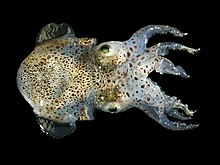| Bobtail squid | |
|---|---|

| |
| Sepiola atlantica | |
| Scientific classification | |
| Domain: | Eukaryota |
| Kingdom: | Animalia |
| Phylum: | Mollusca |
| Class: | Cephalopoda |
| Superorder: | Decapodiformes |
| Order: | Sepiolida Fioroni, 1981 |
| Families | |
Bobtail squid (order Sepiolida) are a group of cephalopods closely related to cuttlefish. Bobtail squid tend to have a rounder mantle than cuttlefish and have no cuttlebone. They have eight suckered arms and two tentacles and are generally quite small (typical male mantle length being between 1 and 8 cm (0.39 and 3.15 in)).
Sepiolids live in shallow coastal waters of the Pacific Ocean and some parts of the Indian Ocean and Atlantic Ocean as well as in shallow waters on the west coast of the Cape Peninsula off South Africa. Like cuttlefish, they can swim by either using the fins on their mantle or by jet propulsion. They are also known as "dumpling squid" (owing to their rounded mantle) or "stubby squid".
Light organ

Bobtail squid have a symbiotic relationship with bioluminescent bacteria (Aliivibrio fischeri), which inhabit a special light organ in the squid's mantle. The luminescent properties of the bacteria regulate gene expression in the light organ. The bacteria are fed a sugar and amino acid solution by the squid and in return hide the squid's silhouette when viewed from below by matching the amount of light hitting the top of the mantle. This method of counter-illumination is an example of animal camouflage.
The organ contains filters which may alter the wavelength of luminescence closer to that of downwelling moonlight and starlight; a lens with biochemical similarities to the squid's eye to diffuse the bacterial luminescence; and a reflector which directs the light ventrally.
Reproduction
Sepiolida are iteroparous and a female might lay several clutches, each of 1–400 eggs (dependent on species), over her estimated one-year-long lifetime. The eggs are covered with sand and left without parental care. Symbiosis with A. fischeri from the surrounding seawater is initiated immediately upon hatching, and the bacteria's colonisation of the juvenile light-organ induces morphological changes in the squid that lead to maturity.
Classification

About seventy species are known. Sepiolid taxonomy within the coleoid cephalopods is currently controversial, thus their position is subject to future change.
- Class Cephalopoda
- Subclass Nautiloidea: nautilus
- Subclass Coleoidea: squid, octopus, cuttlefish
- Superorder Decapodiformes
- Order Spirulida: ram's horn squid
- Order Sepiida: cuttlefish
- Order Sepiolida: bobtail squid
- Family Idiosepiidae
- Family Sepiolidae
- Order Teuthida: squid
- Superorder †Palaeoteuthomorpha
- Order †Boletzkyida
- Superorder Octopodiformes
- Superorder Decapodiformes
References
- Gustavo Sanchez; Jeffrey Jolly; Amanda Reid; Chikatoshi Sugimoto; Chika Azama; Ferdinand Marlétaz; Oleg Simakov; Daniel S. Rokhsar (2019-12-11). "New bobtail squid (Sepiolidae: Sepiolinae) from the Ryukyu islands revealed by molecular and morphological analysis". Communications Biology. 2 (465): 465. doi:10.1038/s42003-019-0661-6. PMC 6906322. PMID 31840110.
- ^ McFall-Ngai, M.J. (1999). "Consequences of evolving with bacterial symbionts: Insights from the Squid-Vibrio Associations". Annual Review of Ecology and Systematics. 30: 235–256. doi:10.1146/annurev.ecolsys.30.1.235.
- Peyer, Suzanne M.; Pankey, M. Sabrina; Oakley, Todd H.; McFall-Ngai, Margaret J. (February 2014). "Eye-specification genes in the bacterial light organ of the bobtail squid Euprymna scolopes, and their expression in response to symbiont cues". Mechanisms of Development. 131: 111–126. doi:10.1016/j.mod.2013.09.004. ISSN 0925-4773. PMC 4000693. PMID 24157521.
External links
| Taxon identifiers | |
|---|---|
| Sepiolida | |